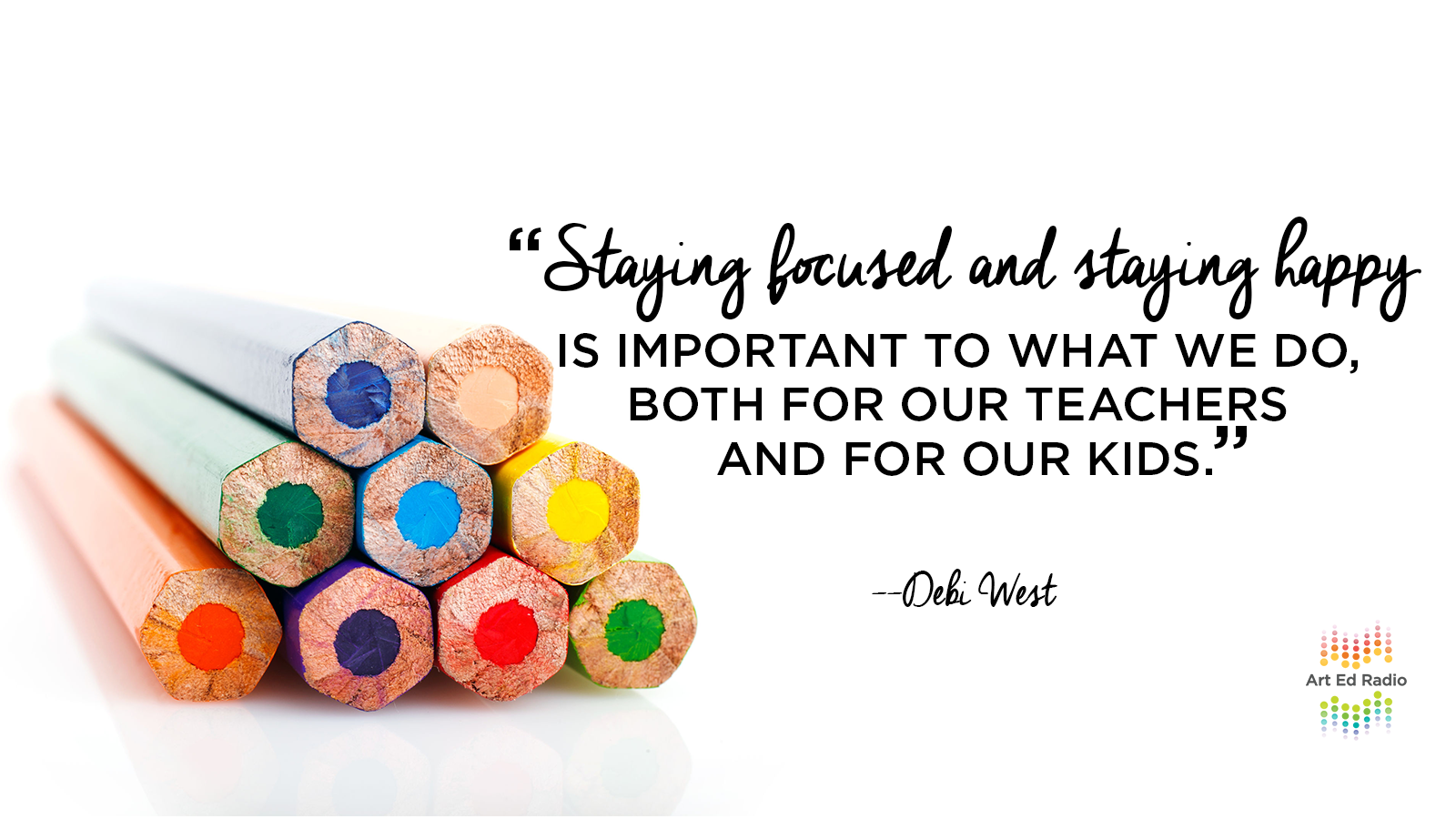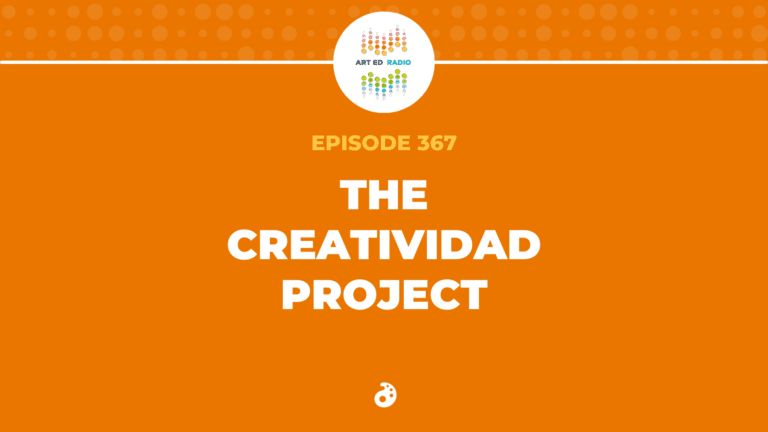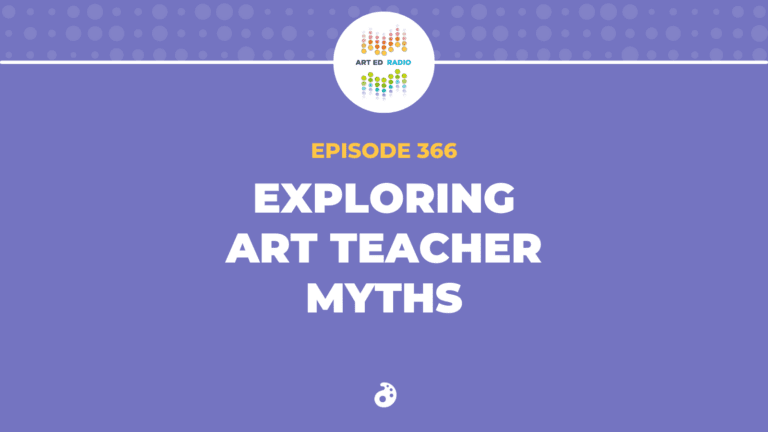Are you looking to improve morale amongst your colleagues and staff? Why not paint your staff bathrooms? It may sound like an idea that’s a little bit out there, but AOE Writer and Instructor Debi West will convince you it’s the way to go! Listen as she talks to Tim about the inspiration behind the idea, how she works with her kids to advocate for her program, and what she is thankful for as an art teacher. Full episode transcript below.
Resources and Links
- How to Build Staff Morale One Bathroom Makeover at a Time
- How to Make Art a Valued Part of Your Community
- All of Debi’s AOE Articles
- One of Debi’s Previous Art Ed Radio Appearances

Tim: Welcome to Art Ed Radio, the podcast for art teachers. This show is produced by The Art of Education, and I’m your host, Tim Bogatz.
A couple weeks back, we had a really interesting article come out from Debi West, Which was all about painting the bathrooms at your school, and I’m going to admit, I was a little skeptical, okay? It seemed weird to me that we should be painting bathrooms, but I think the article was pretty good. She had some good ideas in there, and she’s convinced me that maybe painting staff bathrooms really is a worthwhile endeavor. But, obviously, we need to talk about logistics, like how do you even start figuring out how to paint a bathroom? And do you just close it down while it’s being painted? Where does everybody go? So many questions. So many questions. But, you know, more seriously, I do want to talk to Debi, so I invited her on today, about how to make your art program a bigger presence in your school, and why that is so important.
Debi has a lot of experience. She does a great job of making her art program a vital part of her school, and more importantly, of her community. You know, and Debi’s also a wonderful storyteller. It always entertaining to talk to her, and more often than not, she has some great advice and some wisdom that she can share, so without further ado, let me go ahead and bring her on.
And Debi West is back on the show, joining me now. Debi, how are you?
Debi: Doing great Tim, thank you.
Tim: Oh, good. Good, good. I have lots of exciting questions for you today, but first of all, we need to talk about you hanging out and painting the bathrooms, because you had that awesome article that came out at the end of last month, about painting murals in the staff bathrooms.
Debi: Yes.
Tim: I guess my biggest question is how did that idea come about, and can you talk just a little bit about the inspiration, and then the process of creating those murals with your kids?
Debi: Absolutely. Thanks for asking. So, it actually came about with me just having one of those days, you know? Imagine that, art teachers having crazy days, and trying to keep it all together with the 50 things on our list of to-dos. So I went into our faculty bathroom, and I sort of slammed the door, and as I sat there, you know, doing what you do, I’m looking at these very stark, boring, white walls, and it dawned on me that I had about 188 students right down the hallway that could transform those walls into something that might actually have folks leave that bathroom in a happy place, you know, in a happier mood.
So, I finished up, and I ran down the hall, and I said to my kids, “I got a vision. Come with me.” So a handful my kids walked down, and we found ourselves standing in this tiny little hallway, or in this tiny little bathroom stall, and I’m like, “Okay. What do you guys see?” and they’re like, “A bathroom.” I’m like, “Right, but what do you really see?” They’re like, “Four blank walls,” which equals, big blank canvases.
So I kind of told them my vision, and they were like, “That’s a great idea.” So with that, they went back to the art room and got together with some National Honor Society students, you know, because they’re always looking to do their service hours, and they came up with some great visions, of how we could transform that bathroom into something that would be, I guess a motivator or a happy place for teachers to go and just sit and think for a moment, and then come out just maybe a little rejuvenated, and kind of as a reminder, like what do we do as educators, and how important is our job? And staying focused and staying happy is a big part of what helps motivate our kids.
So I had them go down and talk to some of the other teachers that utilize that bathroom, and everybody was just really excited from the start, and there you go. And now, it became something where we then finished that bathroom, and then we went into the next bathroom, and it sort of just grew. So, it was fun, it got the kids involved, and it definitely helped to build staff morale, which I think is something that art teachers should consider now and then, is being that vibrant, colorful, somewhat loud, somewhat crazy-ish person at school. How can you be one of those folks that kind of help to build staff morale and keep everybody light and happy?
Tim: Yeah, for sure, and I want to talk about that a little bit more in just a second, but I know everybody can kind of go see that article and see some of the photos of what you did, but can you just give us a quick description of kind of the subject matter, like what you painted on there that was kind of inspirational?
Debi: Sure, yeah. You know, I’m always about my kids doing research, you know? Instead of just, “Okay. Here’s your paper, or here’s your canvas, and just draw something from your imagination.” So, we had just been talking about altered books, and visual journals, and artist trading cards, and that whole idea behind taking a really good drawing, and then what? You know, never sort of underestimating the power of negative space. And so through the art of collage, stories are sometimes very visually, excitingly … Is that a word, excitingly? Told … It’s a word now, excitingly told. So, with that, they went and looked at a book by Karen Michel, and it’s called Altered Visions, I believe, and it’s all about altered books, and then they were sort of inspired by David Modler’s book, The Journal of Fodder Junkies, and looked at just a bunch of these different journaling books to come up with ideas.
And then at the same time, they also started looking at motivational quotes, and they kind of merged the two, and they asked, you know, “What do you think of this?” and I kind of looked at them and said, “What do you think of this? If you love it, I’m going to love it. Now go.” And then, here’s a really funny one. So as they started working on that bathroom, one of my administrators came to me and said, “So, my son,” he was in first or second grade at the time, “he comes to school with me in the morning and then takes the bus to the elementary school, and he’s freaking out excited about this bathroom,” because he’s one of the few kids that’s actually allowed to go in that bathroom, with mom.
So, she goes, “He loves dinosaurs.” I was like, “Say no more,” so I told some of my kids, and the next time I turn around, they’re painting this giant dinosaur, like I don’t even know. This kid, of course, knew, because that was his thing, and they did that for him. So that sort of became his … And now I think he’s in fifth or sixth grade now, and he’s still like, “Mom, I got to go see my dinosaur.” Like, he loves that dinosaur.
So, they were taking inspiration from so many other people as well, which is, I think, what made the whole collaboration come to life so well. And then, every now and then, we would paint these really cool, painted stars, and then we would hang them on cardboard or poster board, and sort of splash paint or whatever, and then hang them from the ceiling, and the administrators would let me know when the fire marshal was coming, so we would go in and take them down, and then when the fire marshal left, we put them back up. I don’t know if I should say that one out loud.
Tim: Yeah, probably not, but that’s okay.
Debi: Yeah, shh, right?
Tim: So, if we can circle back around, though, just to kind of the idea of advocacy in general, and like you said, bringing that vibrancy, that excitement to the classroom, and building morale inside your building, right? Why do you think that’s so important?
Debi: Building excitement in the building is important because you have to be there to support and excite the kids. Like, that’s our job. Our job is to teach kids first and foremost, so if we’re not excited, and pumped up, and happy to be there, our kids know that, so that, to me, is the first, most important thing. And kids will come to you and tell you, “Oh, such and such isn’t a very good teacher,” and I always go, “Why? Why is that person not a good teacher?” And nine out of 10 times, the first thing they say is, “Well, they don’t want to be here. You can tell they don’t love it,” versus the teachers that do love it.
So I think all that goes together with advocacy, and there’s like educational advocacy, and then there’s art educational advocacy. So for me, obviously, being an art teacher for 25 years, I’m always advocating for a visual art education for every learner, you know, K through 12, and there are millions of kids right now that don’t get an arts education, and I think that is probably one of the biggest travesties in our country.
So, I believe that being an advocate is synonymous with being an art teacher. They’re sort of one and the same, but as far as then taking that advocacy and then spreading it out into the school, I’ve always been a huge fan of really inspiring and motivating all the teachers, like, “You know what? You have the power to change a kid’s life, not just in art, in every subject, that you’ve got to be as excited about it as you want your kids to be as excited about it.”
Tim: Yeah, I think that’s a good way to think about it. So, let me ask you this. Like, for people who maybe don’t do a lot of advocacy, or don’t feel like they know how to, what are a couple suggestions you have? Like, what are a couple easy things they can do, to get started to advocate for their program?
Debi: Right, well that’s a great question, Tim. I think that there’s a couple ways to look at that. The first is who do you want to advocate to? Are you just going to be an advocate in your school, and kind of get your school to go, “Ooh, you know what? That art class is kind of cool. That art class kind of matters.” Do you want to take it one step further and move it out into the community? And if you want to do that, then who is your audience? Is your audience the legislators, or the community business owners? Or, the way I started looking at it years ago, the most important folks that we can be advocating, or I guess you could say the VIPs, are the parents, because the parents are the ones that care most about their children, and they want the best for their children.
In any setting, parents are going to want the best for their children, but often, they’re a little bit ignorant as to what the arts can be. If they’ve never had an art education, they don’t get why it’s so vitally important. So, I feel like it’s our job to really be educating the parents and explaining to them, over and over and over again, in a fun, exciting way, why art class matters, why it is … This is not arts and crafts. Art class is life class, so getting that information out there to the parents, and then, once you’ve educated the parents, and you’ve got the parents on board, they are the taxpayers, they are the voter enterers, right? They’re voting in the legislation, and once they have that full buy-in, I don’t think that we’re going to see as many arts programs cut anymore, you know?
I was really fortunate that I spent my whole career in Gwinnett County, Georgia, and we’ve never not had art, but I know my second year there, it was threatened for a moment, by the governor, and I kid you not that there were close to probably 8,000 parents that basically stormed the Gwinnett County, I guess school board, and literally the next day, our superintendent said, “Wait, what? Oh, no, no, no, we would never say that,” and boom, just like that, that whole notion went away, that they would never cut the arts. So, we had been … You know, and that was both art and music, and obviously, the music folks are very loud advocates, but all of us working together, I think was a really great light bulb moment for me, as a new teacher, going, “Wow, parents matter. These booster clubs matter.” And by the way, why are we not having more booster clubs in visual arts, right? There is a great advocacy tool in and among itself.
So, you know, I just feel like it’s one of those things that we just can’t ignore, so, you know, who do you want to advocate to? How big and how loud do you want to go?
Tim: Yeah, I think that’s a good question, a good place for people to kind of get started thinking on what they can do, and that is a lot of good suggestions there. I wanted to switch gears, though, with something else that I wanted to ask you about, because we’re getting close to Thanksgiving here, and I know you wrote an article all about thankfulness and all the things that you’re thankful for in this huge career that you’ve had in art ed, and I think you had something like 20 things on that list, but can you just share a couple that you think are maybe most meaningful to you?
Debi: Oh, yeah, thank you for asking. I have to tell you, I loved writing that article. I’ve been doing so much reflecting lately, now that I’m retired-ish, and I keep that -ish on there, because I’m working a lot now, just not in the classroom. But, the things that I missed the most, and that I’m most thankful for … Oh gosh, I mean, I kind of want to list all 20 of them, and the funny thing is, I think I sent Amanda a message and said, “Can I make it 30?” and she was like, “Yeah, no. We’re going to stick with 20 at the moment.”
But obviously first and foremost are the kids. I mean, I miss my kids every single day, and it was connecting with those kids, and building relationships with those kids, and the communication, and relationships, and friendships that I have from being these kids’ teacher. And I think it’s reciprocated. They taught me well too. They really did. So, you know, the kids are probably what I’m most thankful for, and having that opportunity to teach and learn from the future, you know, from kids that are now … You know, I’ve got kids that are married, and have babies, and I’m going to weddings, and showers, and hearing from them all the time, and that is our greatest gift as educators, hands down.
So I start with that, and then I move on to, I guess talking about how we learn from kids. Just being that lifelong learner, you know? As educators, we owe it to our kids to continue learning, be it through graduate programs, through conferences, through being involved with your state organization, through being involved with The Art of Ed. Being that lifelong learner, and then taking that information that you learn back to your kids is going to do nothing but just enhance the field and the learning that goes on in the classroom.
Wow, writing. I am a curriculum nerd, Tim. Oh my gosh. I didn’t realize it, but I absolutely loved writing cool, creative curriculum, and I love that the visual art teachers are one of the few that are really allowed to do that, you know? We look at the state standards. We looked at our district standards, our county standards, and then we go, “Oh, wow. Now we get to design a curriculum that works specifically for our kids in our school.” So that was always a … oh gosh, just a really cool experience, in that it was always evolving, you know? And that’s another reason to go to conferences and keep that network tight so that you can really get out there and learn new ways for kids to learn.
So, writing curriculum was great, and then working with the art tribe, you know? I call art teachers the art tribe, so through George Art Ed Association, and through the National Art Education Association, and I just was up in North Carolina last week, and met some of the most incredible art teachers, and came back, and actually was a little bit sad that on Monday morning, I couldn’t get up and go back into my classroom and go, “Oh my gosh, wait until you hear what I learned this weekend,” you know? So instead, I had to reflect on my own, and then think, “Okay, how am I turning some of this into more articles to share, or into ways that I can teach teachers?” which is what I’m doing now.
Gosh, and making art, and having the studio, and dressing the part, and there’s just so many. I mean, I think that art teachers, we absolutely have the best job in the world, so if you’re not waking up every day and giving a little bit of thanks, and remembering how truly blessed you are, then rethink it, because y’all are lucky, and at the end of the article, I do say how thankful I am for all the art teachers out there, because it’s the greatest job in the world, but it’s a tough job, and what we’re expected to do and how we do it, it needs to be applauded, so I’ll use this moment to just thank everybody. When I say that, I actually get choked up, because I love art teachers so much that it just fills my heart.
Tim: Yeah, that’s awesome, and I don’t know, you say that better than I think anyone else does, right there, so thank you for doing that, and as I said, you know, I think it’s important to remind people that their hard work does not go unnoticed. But we’ll go ahead and just leave it with that, that kind of positivity and that affirmation. So, Debi, thank you so much for your time today. It’s always awesome hearing from you.
Debi: Thanks so much, Tim. I really appreciate it, and I’m thankful for you and The Art of Ed too, so with that, have a good one.
Tim: Thank you to Debi for coming on. As I said in the intro, you know, she is always entertaining. She is so passionate about teaching art and teaching kids, and like I said, she always has some great advice and some wisdom to share, and I appreciate her coming on and sharing that with everyone today.
Now, before we go, I do want to talk to you about Art Ed PRO. There are now almost 85 learning packs that we have developed, and the library included on-demand professional development with video tutorials, downloadable handouts, and all kinds of other resources to help take your teaching to the next level. There are three new Learning Packs released each month, so make sure you check it out at theartofed.com/pro. Now, if you go to The AOE website, there’s also an article up there, pretty easy to find, that has some suggestions on how to get your administrator to pay for a PRO subscription for you, which is happening more and more often. So, once you’re done listening to this, go see what’s there, and see if you can get your admin to pay for pro for you. Okay, I think that is it.
Make sure you check out Debi’s article about painting bathrooms. I will make sure we link that in the show notes, and tomorrow, her article on thankfulness and what she’s thankful for as an art teacher will be up on the site. So, enjoy your time off for Thanksgiving. Spend some time figuring out which bathroom is going to be painted next.
Art Ed Radio is produced by The Art of Education, with audio engineering from Michael Crocker, so Happy Thanksgiving. There is no episode of Everyday Art Room this week, because of the holiday, but we will be back next week on Tuesday, and Cassie will be back next Thursday, as we get back on course with our regular schedule, so enjoy the holiday, and we will talk to you next week.
Magazine articles and podcasts are opinions of professional education contributors and do not necessarily represent the position of the Art of Education University (AOEU) or its academic offerings. Contributors use terms in the way they are most often talked about in the scope of their educational experiences.



